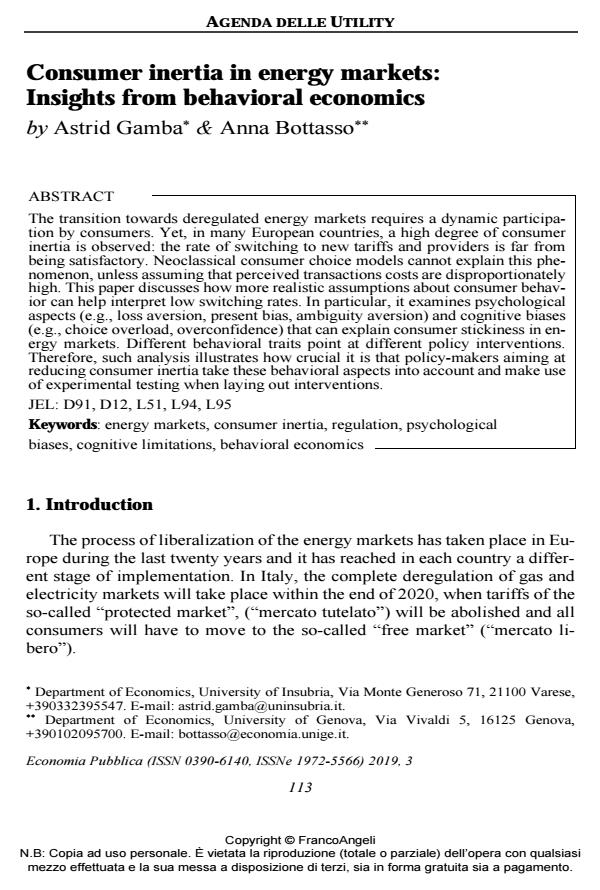Consumer inertia in energy markets: Insights from behavioral economics
Titolo Rivista ECONOMIA PUBBLICA
Autori/Curatori Astrid Gamba, Anna Bottasso
Anno di pubblicazione 2020 Fascicolo 2019/3
Lingua Inglese Numero pagine 18 P. 113-130 Dimensione file 100 KB
DOI 10.3280/EP2019-003005
Il DOI è il codice a barre della proprietà intellettuale: per saperne di più
clicca qui
Qui sotto puoi vedere in anteprima la prima pagina di questo articolo.
Se questo articolo ti interessa, lo puoi acquistare (e scaricare in formato pdf) seguendo le facili indicazioni per acquistare il download credit. Acquista Download Credits per scaricare questo Articolo in formato PDF

FrancoAngeli è membro della Publishers International Linking Association, Inc (PILA)associazione indipendente e non profit per facilitare (attraverso i servizi tecnologici implementati da CrossRef.org) l’accesso degli studiosi ai contenuti digitali nelle pubblicazioni professionali e scientifiche
The transition towards deregulated energy markets requires a dynamic participation by consumers. Yet, in many European countries, a high degree of consumer inertia is observed: the rate of switching to new tariffs and providers is far from being satisfactory. Neoclassical consumer choice models cannot explain this phenomenon, unless assuming that perceived transactions costs are disproportionately high. This paper discusses how more realistic assumptions about consumer behavior can help interpret low switching rates. In particular, it examines psychological aspects (e.g., loss aversion, present bias, ambiguity aversion) and cognitive biases (e.g., choice overload, overconfidence) that can explain consumer stickiness in energy markets. Different behavioral traits point at different policy interventions. Therefore, such analysis illustrates how crucial it is that policy-makers aiming at reducing consumer inertia take these behavioral aspects into account and make use of experimental testing when laying out interventions.
Parole chiave:Energy markets, consumer inertia, regulation, psychological biases, cognitive limitations, behavioral economics
Jel codes:D91, D12, L51, L94, L95
- Pricing in the shadows of inattention: An information-theoretic model of prosumer inattention in residential solar tariff Sreelatha Aihloor Subramanyam, Xuewei Zhang, in The Electricity Journal 107503/2025 pp.107503
DOI: 10.1016/j.tej.2025.107503
Astrid Gamba, Anna Bottasso, Consumer inertia in energy markets: Insights from behavioral economics in "ECONOMIA PUBBLICA " 3/2019, pp 113-130, DOI: 10.3280/EP2019-003005